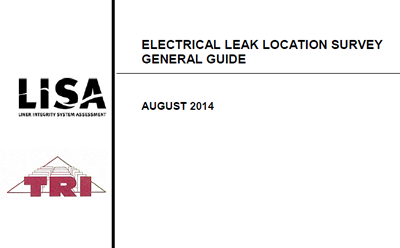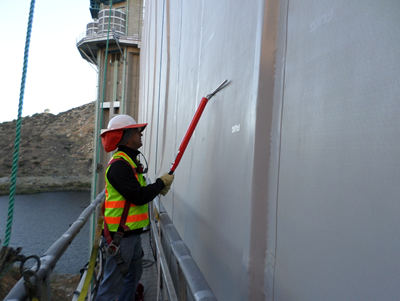 TRI Environmental has published an updated Electrical Leak Location Survey General Guide. This publication (August 2014) closely follows the release of ASTM International Committee D35’s new standard, D7953 – Standard Practice for Electrical Leak Location on Exposed Geomembranes Using the Arc Testing Method.
TRI Environmental has published an updated Electrical Leak Location Survey General Guide. This publication (August 2014) closely follows the release of ASTM International Committee D35’s new standard, D7953 – Standard Practice for Electrical Leak Location on Exposed Geomembranes Using the Arc Testing Method.
DOWNLOAD A COPY OF THE ELL GUIDE (PDF)
The most substantive change in the guide is its inclusion of an official section on arc testing technology.
In a 28 July 2014 press release regarding the new standard, TRI Liner Integrity Service’s Abigail Beck, who served on the D35 sub-committee, noted, “The arc testing method evolved from the spark testing method, but is quite a different technology. Spark testing is specifically used for coextruded conductive-backed geomembrane, while the arc tester was specially designed to use natural materials (soil, clay, rock) as the conductive medium for the electrical path. While the spark tester uses a build-up of electrical potential to discharge discrete sparks, the arc tester maintains a continuous electrical arc.”

Beck has also published a longer piece on the arc testing advances here.
The August 2014 edition of the ELL guide addresses:
- Exposed Geomembrane Surveys
- Water Puddle Method (ASTM D7002)
- Water Lance Method (ASTM D7703)
- Conductive-Backed Geomembrane Spark Testing Method (ASTM D7240)
- Arc Testing Method (ASTM D7953)
- Covered Geomembrane Surveys
- Dipole Method – Soil Covered Geomembrane (ASTM D7007)
- Dipole Method – Water Covered Geomembrane (ASTM D7007)
A secondary section in the guide is dedicated to designing for electrical leak location surveys. That is, how to ensure that a site is surveyable, considering both current state-of-practice for lined facilities and evolving leak location equipment for all methods of survey.











